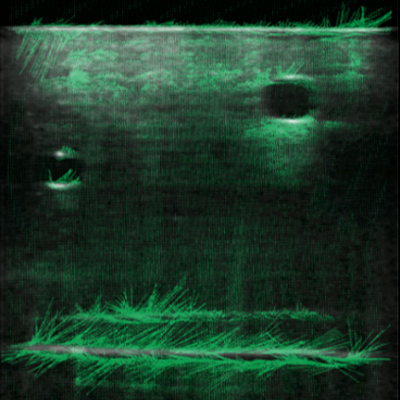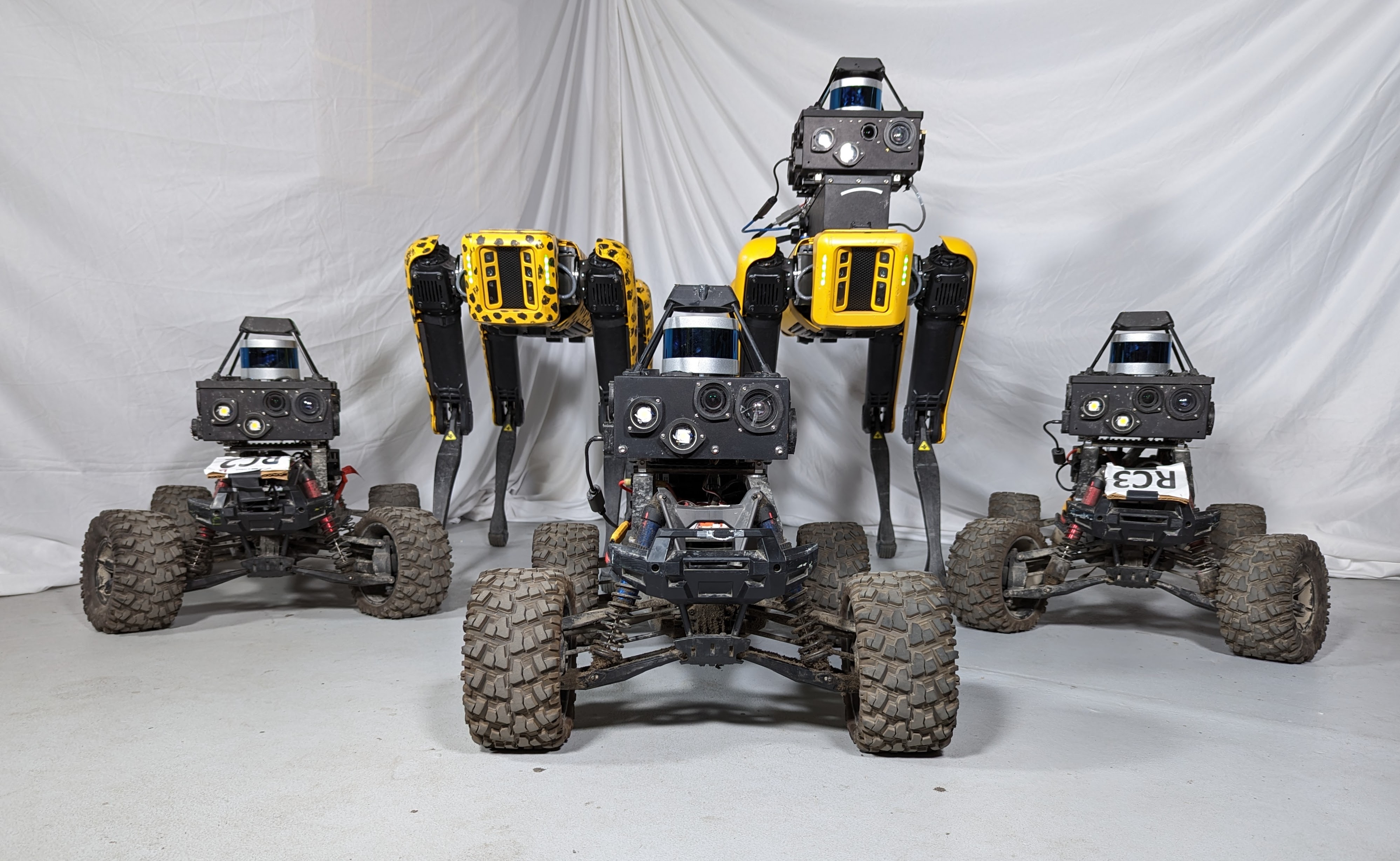Ergodic Search
Table of Contents
| System | Multi-Objective | Multi-agent | Heterogeneous agent |
|---|---|---|---|
| MO-ES | ✅ | ||
| MO-MA-ES | ✅ | ✅ | |
| HE-MO-MA-ES | ✅ | ✅ | ✅ |
Multi Objective Ergodic Search
Our work is motivated by humanitarian assistant and disaster relief (HADR) where often it is critical to find signs of life in the presence of conflicting criteria, objectives, and information.
We believe ergodic search can provide a framework for exploiting available information as well as exploring for new information in applications such as HADR. Ergodic search algorithms plan trajectories such that the time spent in a region is proportional to the amount of information in that region, and is able to naturally balance between exploitation and exploration.

Existing ergodic search methods typically consider search using only a single information map. However, one can readily envision many scenarios where multiple information maps that encode different types of relevant information are used. Ergodic search methods currently do not possess the ability to simultaneously search multiple information maps, nor do they have a way to balance which information gets priority.
This leads us to formulate a Multi-Objective Ergodic Search (MO-ES) problem, which aims to find the so-called Pareto-optimal solutions, for the purpose of providing human decision makers various solutions that trade off among conflicting criteria.
To efficiently solve {MO-ES}, we develop a framework called Sequential Local Ergodic Search (SLES), which leverages the recent advances in ergodic search methods as well as the idea of local optimization to efficiently compute Pareto-optimal solutions. Our numerical results show that SLES computes solutions of better quality and runs faster than the baselines.
Multi Agent Multi Objective Ergodic Search

Having formulated the multi-objective ergodic search problem, this work deals with the extension of the work to multiple agents.
In order to find points of interest in a given domain, many planners use a priori information to guide the search to expedite the detection of targets. Information-based search techniques use an a priori information map, typically represented as a probability distribution, to guide their search. An information map can describe, for example, the likelihood of finding survivors at a location in search and rescue applications. We present an approach to direct multiple agents (MA) to search a given domain subject to multiple objectives (MO), each characterized by its own information map. Our approach embraces an information-based method, called ergodic search (ES). ES utilizes an ergodic metric, defined later in this work, that is minimized when the time spent by an agent in a region is proportional to the amount of information contained in that region. In this thesis, we introduce the Multi-Agent Multi-Objective Ergodic Search (MA-MO-ES) problem and prescribe computationally efficient methods to solve it.
The primary goal of this work is to determine the trajectories for all agents such that the worst-case objective or highest ergodic metric on any information map is minimized (minmax objective). Naively computing a joint trajectory of all the agents by optimizing the ergodic metric on the average of all the information maps results in a high ergodic metric with respect to each map. This is because spending time in the high-information region on one map can correspond to spending time in the low-information regions of another map. If each agent’s trajectory is instead computed by considering a subset of maps, our results show that the maximum ergodic metric on the information maps can be considerably reduced. This requires determining which information maps should be considered when optimizing the trajectory of a particular agent. In other words, this work computes the optimal allocation, of information maps to agents, that minimizes the maximum ergodic metric on the given information maps.
The main challenge in determining the optimal allocation is the exponential growth of the number of possible allocations with the number of maps and agents. Further, computing the cost of an allocation is itself an expensive planning problem. This is because evaluating an allocation requires identifying the maximum ergodic metric with respect to the information maps by computing the trajectory for each agent that optimizes the ergodic metric on its assigned maps. The expensive evaluation of one allocation coupled with the exponentially growing number of possible allocations makes solving for an optimal allocation using brute force computationally intractable.
To mitigate the computational challenge of exponential growth, we present a branch and bound-based algorithm with pruning techniques that reduce the number of allocations to be searched to find the optimal allocation. To reduce the branching factor in branch and bound, we propose two approaches for clustering information maps before allocation: k-means and minimum bounding sphere clustering. This sacrifices guaranteed optimality in exchange for improved computational performance. These clustering approaches leverage the similarity between information maps to approximate the cluster of maps that should be assigned to a single agent to achieve minmax ergodic metric on the information maps. Clustering information maps before allocation decreases the number of possible allocations and thus the branching factor in the branch and bound, further reducing the problem’s computational complexity. Testing on 70 randomly generated test cases shows an order of magnitude improvement in runtime for our branch and bound approach compared to an exhaustive brute force approach. Using similarity clustering, the runtime further reduces by two orders of magnitude even for tests with ten information maps and four agents while maintaining good quality allocations with an average 20\% deviation from the optimal minmax ergodic metric.
Heterogeneoug Multi-Agent Ergodic Search
Multi-robot systems can provide greater sensor coverage and reliability than single robot systems. Among multi-robot applications, significant research effort has been devoted to multi-agent search, where deploying numerous agents can greatly improve the time-efficiency and robustness of search. Motivated by such problems, we consider the large-scale deployment of heterogeneous robots in time-critical scenarios, where search can be further improved by leveraging the natural synergies between agents’ sensing and motion capabilities. By optimizing the formation and coordination of teams of heterogeneous agents, we can efficiently cover a large search area, while managing complexity, to allow for rapid, online re-planning as more information is gathered. This work addresses the question: How can we best form and coordinate heterogeneous agent teams?

Our approach is based on ergodic search processes, which, similar to other information-theoretic coverage methods, rely on an a priori information distribution, representing the likelihood of finding a target at any point over the search domain, to guide the search. Ergodicity is a measure of how much time an agent spends in a region of space weighted by the likelihood of a target being located in that region. By optimizing over search paths (really the parameters that describe the paths) the ergodic metric drives agents to spend time in areas of the domain in proportion to the a priori likelihood of finding targets in these areas, while still covering the whole domain, thus balancing exploration and exploitation. Often, this optimization is performed in the spectral domain, by minimizing the difference between the coefficients associated to the team’s time-average statistics (i.e., fraction of the time spent in each area) and those of the information distribution.
The contribution of this work is to exploit the spectral nature of the ergodic metric in search scenarios involving heterogeneous agents. We do this by planning search paths for each agent type based on a smaller subset of the spectral coefficients associated with the information map, thus driving agents to search the domain at a spatial scale that best matches their motion and sensing capabilities. This technique decomposes the search task and distributes the subtasks to agents based on their capabilities. We demonstrate that these new insights lead to improvements in search domain coverage and time taken to find targets.
Current research focuses on applying machine learning techniques to automate both the creation and distribution of search subtasks. By allowing agents to thus learn and utilize their unique strengths, we can generalize this approach to more complex agents, where human intuition may not suffice. Additionally, we are exploring extending this work to incorporate decentralized planning in order to efficiently scale to large numbers of agents. Finally, branch-and-bound techniques are being explored as a way to efficiently analyze assignments of heterogeneous agents to different search tasks.


